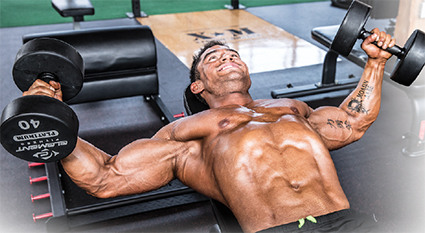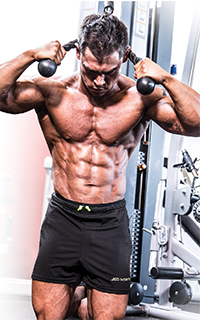Supersetting for Superior Muscle Size

Supersetting for Superior Muscle Size
Use this advanced training principle for big gains in the gym
While Joe Weider corralled supersets among his legendary “Weider Training Principles,” I think there’d be some doubt as to the legitimacy of such an audacious claim. It would be like me trying to lay claim to the question mark, or the rooster taking credit for the dawn. Just a few minutes after Joe Gold invented the first bodybuilding gym, we got supersets, overnight, just like mushrooms. It’s one of those techniques that invented itself, an absolute inevitability.
Weider was a genius marketer. Long ago, at the dawn of the muscle movement, he sold workout programs that were a clever melange of “Weider Training Principles.” You have to give him credit for creativity and marketing savvy, but you can’t credit him for many of the ideas bodybuilding already had. I’m talking about things such as the Weider super slow principle, or rest-pause, or forced reps, or the Weider overload principle. He may have named them, packaged them, and sold them, but, in reality, a superset is something bodybuilders have been doing since Milo walked up the hill with the cow on his back. As soon as he walked back down the hill, boom, we had supersets.
But why then, would something so basic and inevitable be considered an advanced training technique? Because, to endure them—i.e., “execute them properly”—you need to be at an advanced level of training, or at least ready to accept repeated bouts of pain so grievous that just knowing you’re going to do one should give you the same anxiety you’d normally feel knowing you’re going to the dentist to have a tooth drilled without novocaine. If that idea appeals to you, then supersets are a must-have in your arsenal of self-flagellation training tools.


Supersets are perfect for those who believe weight training is a business best conducted solo, because they allow mortification of the flesh with no help. You don’t need a training partner. All you need to do is decide what type of superset you’d like to employ, set up the stations, then turn up your iPod and have at it.
In deciding your superset arrangement, you have quite a list from which to choose. No one really knows if there is a complete list because the variations are practically endless once you determine what you want to accomplish. Whether you’re employing supersets to fulfill the sadistic needs of high intensity training or the grueling repetitions of volume training, one of the aims in employing a superset is maximizing muscle fibre recruitment. A muscle fibre cannot be subject to training stimuli if it isn’t recruited first.
For example, a muscle, for all intents and purpose, is a bunch of muscle fibres held together in a bag that gives it its shape (fascia). Biceps is a simple example: two elongated bags of muscle fibres, one shorter and smaller than the other, connected on either of the ends by tendons, originating on the front of the scapula and inserting below the elbow—one tendon on the ulna and the other the radius—each one covered in fascia like a tube sock.
When your brain gives the order to lift your hand up from your side in a curling motion, the number of fibres recruited for the cause is determined by the opposing gravitational stress on the palm of your hand. With nothing in your hand, the action requires little power; just a few fibres need to contract in order to lift your empty hand. The rest of the fibres in the bundle aren’t activated; they just go along for the ride. Now, with a 50-pound dumbbell in your hand, the gravitational stress is much greater, requiring more power to complete the contraction and thus the need for more muscle fibres to be recruited. Add some cheat reps with that 50 and you recruit more, drop the 50s and pick up a pair of 30s and keep repping and you’ll recruit even more fibres, superset cheat curls with hammer curls and you’ll recruit more still. Whether you take those fibres to failure or complete a specific rep scheme, you have to first get their attention.

 AGONISTIC SUPERSETS
AGONISTIC SUPERSETS
There are two basic types of supersets, and under each of those, several others. The biggest group would be the agonist supersets—working the same muscle, from different angles, to recruit as many fibres as possible. In the biceps example above, we supersetted heavy cheat curls with hammer curls. This targets both the long and short heads of the biceps by alternating one exercise with the wrist supinated with another with the wrist pronated. Or, you could superset heavy preacher curls with light concentration curls to recruit both fast- and slow-twitch muscle fibres. Or, you could superset static pause barbell curls with close-grip camber curls, thus graduating from a weak position to a stronger one to really burn out. The variations are only limited by your imagination.
Some agonist supersets can be employed to pre-exhaust a muscle that works in a compound movement. Chest is a good example. While the primary mover in a pressing movement is the pectoralis, it’s assisted in such a compound movement by the triceps and to some degree the front delts. By supersetting an isolation movement with a compound movement, you can pre-exhaust the pec by isolating it, and then further stress it by bringing in the fresh triceps and delts. For example, superset pec deck with seated machine presses. The pec deck will isolate the pec muscles and allow you to bring them to failure. Then jump off the pec deck and right into the seated press and immediately start doing presses. After just a few reps, your pecs will be screaming. It’s like a self-contained forced rep.
 ANTAGONISTIC SUPERSETS
ANTAGONISTIC SUPERSETS
The second main group of supersets is the antagonist superset. Instead of training the same muscle, antagonist supersets pit one movement against an opposing movement. For example, quads and hamstrings, biceps and triceps, chest and back supersets work muscles in opposing actions.
In understanding antagonist supersets, you must first understand that with the exception of the tongue, muscles only contract. They don’t generate any force to extend. This is why every joint in your body requires muscles on either side of it to extend and contract. Look at a simple example, the elbow. In order to raise the forearm, the biceps must contract. To extend the forearm in the other direction, the biceps relax and the triceps pull the forearm the other way. The biceps don’t extend in the opposite direction with any power, zero.
Antagonist supersets are a great change to a workout, and they’re especially useful for people like me who prefer to train alone and don’t like to sit still between sets. This gives one muscle group time to recover while the opposing one works, and it keeps your cardiovascular rate up and burning lots more calories than sitting around between sets. Keep moving; guys who routinely superset antagonist muscle groups with no rest between sets are usually pretty well conditioned.
The third group of supersets comprise slightly related muscle groups—e.g., quads with calves, traps with forearms, delts with biceps, etc. These could be employed as part of a secondary training regimen to help bring up lagging body parts or cultivate specific points of added strength specific to other sports. Or, you could add them in because you really dig forearms and traps and feel like the extra work is going to do them good.
Regardless of how you employ them, supersets are an age-old advanced training principle that not only bring variety to your training but also are a very effective and versatile tool that can bring your physique to a whole new level.
 Most Popular Agonist Superset Routines
Most Popular Agonist Superset Routines
The goal for each of these supersets is to use the first isolation exercise to pre-exhaust the primary mover, doing as many reps as you can with the selected weight, then immediately following it with the second movement until failure or your specific rep goal. Shoot for 4 or 5 sets incorporated with the rest of the day’s routine.
Flyes + chest press
Barbell curls + hammer curls
Dumbbell lateral raises + seated shoulder press
Leg extensions + leg press
Skullcrushers + close-grip bench
Pull-overs + wide-grip pull-downs

Most Popular Antagonist Superset Routines
Chest + Back
Bench press + seated rows 5 × 10–12
Decline bench press + bent-over rows 5 × 8–10
Incline dumbbell flyes + close-grip pull-downs 5 × 12
Incline bench press + dumbbell rows 5 × 8–10
Biceps + Triceps
Low pulley rope hammer curls + high pulley rope press-downs 4 × 15
Alternate dumbbell curls + dumbbell triceps extensions behind head 4 × 10
Barbell curls + close-grip bench 5 × 8
Scott curls + reverse-grip press-downs 4 × 12
Abs + Low Back
Rope crunches + hyperextensions 6 × 20–25
Hanging leg raises + good mornings 6 × 20–25
Quads + Hamstrings
Leg extensions + lying leg curls 5 × 12–15
Hack squats + stiff-legged deadlifts 6 × 8–10
Get articles delivered to you each month by signing up to the FREE Muscle Insider newsletter. Just click here.


